Julie McInnes (Institute for Marine and Antarctic Studies, University of Tasmania, Hobart, Australia) and colleagues have published a review article in the ICES Journal of Marine Science that looks at methods to analyse diets of albatrosses.
The paper’s abstract follows:
“Many seabird populations are threatened by interactions with commercial fisheries, and climate change. Understanding their prey requirements and dietary flexibility in this context is important for effective conservation and management. However, changes in the methods used to assess diet, as well as the spatial and temporal coverage of monitoring schemes, may reduce our ability to detect and monitor these marine threats. To help assess conservation priorities linked to diet, we performed a systematic review of 109 albatross diet papers published between 1950 and 2016, which corresponded to 296 studies when stratified by sampling year, breeding site, and breeding species. We assessed the methods used, changes over time, and spatial and temporal sampling coverage by species and island group. Most albatross studies have focused on chick-rearing, and diet during other breeding phases is comparatively poorly known. Furthermore, chicks are more commonly sampled than adults and very rarely immature birds, all of which may differ in diet composition. There was a pronounced shift over time in the preferred method of characterising diet, from the morphological examination of prey remains to stable isotope analysis of tissue. This shift has reduced the volume of detailed taxonomic information available from morphological studies. This difference in resolution hinders the ability to detect changes in prey species, with implications for management of threatened albatrosses and for monitoring broader changes in marine ecosystems. In a knowledge gap analysis for important breeding colonies (with >5% of global population), we identified key sites where existing monitoring has provided a foundation for robust longitudinal diet studies. Maintaining and augmenting these long-term research programmes will enable analyses of the impacts of changing climate and fishing practices on seabird populations and facilitate the timely identification and implementation of management options.”

Sooties like squid! Sooty Albatross family on Gough Island, photograph by Kalinka Rexer-Huber
With thanks to Richard Phillips.
Reference:
Julie C. McInnes, J.C., Raymond, B., Phillips, R.A., Jarman, S.N., Lea, M.-A. & Alderman, R. 2016. A review of methods used to analyse albatross diets—assessing priorities across their range ICES Journal of Marine Science doi:10.1093/icesjms/fsw105.
John Cooper, ACAP Information Officer, 24 June 2016

 English
English  Français
Français  Español
Español